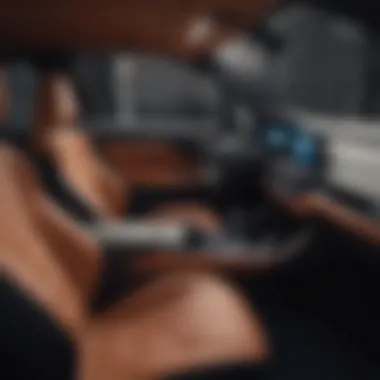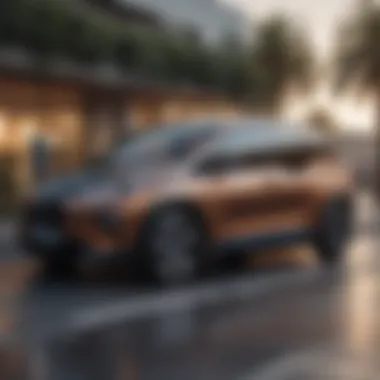Exploring the BMW iNEXT: A Deep Dive into Electric Mobility


Intro
The realm of electric mobility is expanding rapidly, transforming the automotive industry. BMW has entered this space with the iNEXT, an ambitious vehicle that redefines what electric driving can offer. Projects innovatively designed vehicles that not only perform but also integrate advanced technology and an impressive user experience. This article aims to provide a broad insight into the iNEXT, covering essential elements like design, specifications, and market impact. Understanding these factors is crucial for both automotive enthusiasts and potential buyers looking to navigate the modern market of electric vehicles.
In-Depth Car Reviews
Overview of the Vehicle
The BMW iNEXT presents a forward-thinking vision of transportation. Positioned as an all-electric SUV, it emphasizes sustainability while not compromising on luxury and performance. With its sleek lines and modern aesthetics, the design evokes both elegance and innovation. A focus on aerodynamics aims to enhance efficiency, reflecting key values in modern electric mobility. This vehicle symbolizes BMW's commitment to the future of driving.
Key Specifications
Several specifications set the iNEXT apart within the electric vehicle sector:
- Battery Capacity: 100 kWh
- Range: Approx. 300 miles on a full charge
- Power Output: 500 horsepower
- Acceleration: 0 to 60 mph in about 4 seconds
These figures illustrate how the iNEXT aims to compete directly with rivals in the energy efficiency space without forgoing the thrilling performance one expects from a BMW.
Performance Analysis
Beyond mere figures, performance is central to the iNEXT experience. The vehicle utilizes dual motors, facilitating an all-wheel drive. This enhances handling while providing better traction, which is vital for navigating diverse driving conditions. Feedback from initial drives suggests that it delivers a driver-centric experience, with adaptive suspensions that adjust to fluctuations in the road, contributing to smooth rides.
Interior and Exterior Design
On the inside, the BMW iNEXT boasts premium materials adapted to a tech-savvy audience. Spaciousness and comfort are coupled with various high-tech features like an augmented reality head-up display. Unlike many competitors, it incorporates natural elements that minimize the feeling of a sterile cockpit.
On the exterior, the hallmark design of the BMW brand stays intact. The front grille is closed and sleek, gracing a car that maintains a dynamic stance while at rest. This commitment to design ensures that the iNEXT aligns with luxury electric vehicles that command desirability.
Safety Ratings and Features
Safety remains paramount in the iNEXT's design philosophy. The vehicle comes equipped with advanced driver assistance systems. This includes collision warnings, adaptive cruise control, and automated emergency braking, creating an environment that prioritizes safety. While official ratings are still pending from regulatory bodies, BMW’s attention to rigorous testing approximates high confidence in safety standards.
Epilogue
The BMW iNEXT represents a pivotal entry into electric mobility, balancing performance, luxury, and technological advancements. This review provides essential information to automotive enthusiasts and new buyers, paving the way for informed decisions within an ever-evolving market.
Prologue to BMW iNEXT
The launch of the BMW iNEXT represents a significant leap in the automotive sector. This marks an important incident in the context of electric vehicles, illustrating how traditional automotive manufacturers can adapt to new technologies and consumer demands. It is essential to understand the different elements of the iNEXT, especially its implications for the user experience, environmental considerations, and overall performance. The iNEXT integrates strength, innovation, and sustainability into its core, redefining how we perceive electric mobility.
Overview of Electric Vehicles
Electric vehicles (EVs) have emerged as a prominent solution to the global challenge of reducing carbon emissions. They rely on electric energy for propulsion, presenting both environmental and economic advantages. However, the transition from internal combustion engines to electric powertrains is not merely a matter of swapping out one energy source for another. It involves rethinking vehicle design, infrastructure, and user engagement.
The positive aspects of EVs include reduced operating costs, as electric energy is typically cheaper than gasoline or diesel. Furthermore, there is less mechanical wear and tear. Adoption of electric vehicles may lead to the enhancement of cleaner air in urban areas, significantly impacting public health.
People estimate that electric vehicles will dominate around 30% of new car sales by 2030.
On the other hand, potential concerns include issues such as range anxiety, charging infrastructure availability, and battery disposal. A comprehensive overview illicits an honest examination of both advantages and disadvantages educates consumers.
Positioning of BMW in the EV Market
BMW has a unique position in the electric vehicle space. They have invested significantly in electrification technology, committing to a future where electric mobility is clean, intelligent, and progressive. The iNEXT contributes to BMW's vision by demonstrating a fusion of autonomous driving features and electric performance.


With established models like the BMW i3 and iX3, the iNEXT will fit perfectly into the aspirational targets that BMW has set for the next few years.
Especially the younger generations are more tomorrow focused and keen on environmental protection. Thus, positioning the iNEXT in the EV market can capture this demographic. By including high-end technology and luxurious designs, BMW meets the expectations of quality and performance, keeping in mind environmental commitments. However, it is important for them to ensure that they remain competitive ranged against emerging rivals, such as Tesla.
Through strategic collaborations and marketing, BMW is well-aimed to exert significant influence in the electric mobility landscape. Their storied history of performance vehicles creates a bridge as they transition to this new electric future.
This introduction to the iNEXT not only outlines the base of electric vehicles but situates BMW within that vital marketplace. Understanding these fundamentals is essential for appreciating the products contextually in this volatile automotive age.
Design Elements of BMW iNEXT
The design elements of BMW iNEXT are crucial in establishing its identity within the electric vehicle sector. As an innovative model by BMW, every aspect of its design is engineered not only for aesthetics but also for purpose. A thoughtful design enhances functionality, performance metrics, and a pleasing visual appeal. Such considerations empower BMW to attract a broader audience, including discerning automotive enthusiasts and conscious new buyers.
Exterior Design Considerations
From the outset, the exterior design of BMW iNEXT showcases a blend of sleekness and deliberate aerodynamics. It features a distinctive silhouette that meets the objectives of both performance and modern aesthetics. The elongated hood and chiseled lines draw attention while reducing drag, essential for electric vehicles to optimize range. BMW utilizes the latest design language, which represents a shift towards a more futuristic approach without losing the brand's signature styling cues.
Special attention is given to the front fascia, emphasizing a closed kidney grille, which enhances the electric identity of the car. This design element signifies that the iNEXT's focus is no longer on engine cooling but on improving aerodynamics. The sharp LED headlights also contribute to the car's authoritative presence while engaging with headlights that could adjust and optimize based on driving conditions.
In summary, the design of the BMW iNEXT emphasizes streamlined efficiency and aesthetic elegance, important for its role as a leader in electric mobility.
Interior Comfort and Features
Inside the BMW iNEXT, the focus shifts to comfort and technology as essential design elements. The spacious cabin is meticulously crafted to provide both luxury and functionality. High-quality materials adorn the interior, notably the use of sustainable components which contribute to set the stage for an eco-friendly message of the vehicle.
Comfort features include adjustable seating with ample lumbar support, accompanied by a high-quality sound system that delivers an engaging auditory experience. Ambient lighting adds to the customizability, allowing you to influence the overall atmosphere based on your mood or preferences.
In terms of infotainment, the iNEXT integrates seamlessly with modern technology. The central display operates via intuitive gestures, ensuring that drivers and passengers stay connected without distracting from driving tasks. Features such as heads-up display highlight the commitment to providing drivers with comprehensive safety and usability measures.
Thus, the interior design of the BMW iNEXT blends opulence with advanced functionality, making each journey enjoyable and connected.
Sustainability in Material Choices
Sustainable practices permeate the design elements of BMW iNEXT, particularly in the choices of materials throughout the vehicle. This model illustrates BMW’s shift towards environmentally conscious manufacturing methods. Notably, materials sourced from recycled provisions and plant-based sources are on the rise within the interior design.
For instance, instead of conventional leather, BMW offers upholstery made from recycled plastic bottles, presenting a more ecologically responsible furniture. Such materials maintain luxury aesthetics and tactile pleasure without the environmental burden associated with traditional manufacturing.
Moreover, the sourcing protocols in place also demonstrate BMW’s commitment to responsible resource management. From production to distribution, each phase aims to minimize harmful emissions and reduce overall environmental footprints.
Performance Metrics of BMW iNEXT
In the ever-evolving landscape of electric vehicles, performance metrics serve as the cornerstone of understanding a vehicle's true capabilities. For the BMW iNEXT, metrics like power, handling, range, and charging specifications not only reflect the engineering excellence behind its production but also indicate how well it meets consumer expectations in terms of functionality and sustainability. Analyzing the performance metrics of the iNEXT reveals much about how it stands in contrast to competitors and its role in shaping future-winning innovations in the EV market.
Electric Powertrain Overview
The electric powertrain in the BMW iNEXT represents a crucial aspect of its overall performance. It’s vital for several reasons. First, the heart of the iNEXT is a pair of highly efficient electric motors. These motors provide instantaneous torque, ensuring acceleration that rivals even the sportier models in BMW’s lineup. Specific numbers offer insight into capabilities; the iNEXT can achieve a 0 to 60 mph time in under five seconds, which is impressive for an electric SUV.
The integration of a large battery pack enhances this powertrain’s reliability and efficiency. Operated under a state-of-the-art management system, the battery not only meets daily driving needs but also supports long road trips. BMW’s strategy of offsetting weight through lighter materials bolsters the electric powertrain's efficacy, maximizing performance without compromising structural integrity.
Driving Dynamics and Handling
Driving dynamics play a significant role in choosing an electric vehicle. With the BMW iNEXT, the company aims to balance robust performance with driving comfort. By situating the battery pack low in the chassis, the vehicle achieves a low center of gravity. This layout leads to improved agility and handling, giving drivers an experience akin to that of a gasoline-powered BMW.
Steering feedback is precise, further adding to the driver-centric approach that BMW is renowned for. Options for adaptive suspension enhance this, catering to various road conditions while maintaining the agility that distinguishes the brand. Thus, despite the bulk associated with being an SUV, the iNEXT retains sporty handling characteristics that drivers expect.
The driving experience of the BMW iNEXT melds performance and comfort, catering to varied consumer preferences.


Range and Charging Specifications
Compared to many competitors in the EV segment, range remains a key area of interest for potential buyers. The BMW iNEXT doesn’t disappoint. It offers an estimated range surpassing 300 miles on a single charge under standard conditions. This makes it suitable for both urban commuting and longer journeys without constant concerns about charging facilities.
Charging speeds are equally notable. Utilizing rapidly charging technology, the iNEXT can restore a significant portion of its battery with a mere 30-minute charge at a DC fast charging station. This ensures minimal downtime and ease of use as one transitions to electric mobility. Traditional home charging options also exist, making daily charges simple and effective.
With its focus on performance metrics, the BMW iNEXT paves the way for an ideal blend of versatility, excitement, and eco-consciousness. Continuous improvements in these areas solidify its importance in the broader automotive narrative, especially as models gain market traction and consumer acceptance.
Overall, understanding these performance metrics equips potential customers and automotive enthusiasts with the knowledge needed to gauge the vehicle’s full potential.
Technological Innovations in BMW iNEXT
The BMW iNEXT stands at the forefront of electric vehicle innovation. This section will explore technological advancements that define what the iNEXT brings to the automotive world. These innovations are not merely optional extras; they enhance the driving experience and reflect broader industry trends.
Integration of Autonomous Driving Features
The iNEXT incorporates a number of autonomous driving features. These include advanced driver assistance systems, capable of ensuring safety on the road. The highlight here is the suite of Level 3 automation capabilities. This allows the vehicle to handle substantial driving tasks while the user can focus on other activities.
For example, during highway driving, features such as lane-keeping assistance and adaptive cruise control come into play. They can intuitively respond to traffic conditions. Moreover, these features are constantly updated via over-the-air updates, ensuring the systems stay current. This integration positions the BMW iNEXT among the leaders in autonomous technology in electric vehicles.
Connectivity and Infotainment Systems
Connectivity is increasingly vital in modern vehicles. The BMW iNEXT showcases an advanced infotainment system that balances utility and sophistication. An important element is the iDrive 7.0, which provides intuitive navigation and multimedia options. Drivers can easily access smartphone compatibility through Apple CarPlay and Android Auto, enhancing convenience.
The vehicle is equipped with a powerful voice control system. This allows the driver to perform various tasks hands-free, further augmenting safety. Connectivity extends to an online interface where the car can access real-time traffic information to optimize routes. Such integrations ensure that users can remain productive, entertained, and informed during their drive.
Safety Technologies and Ratings
Safety technologies in the BMW iNEXT exemplify the brand's commitment to consumer protection. Comprehensive safety measures include multiple airbags, advanced braking systems, and stability control. Furthermore, the vehicle has received favorable ratings from various safety organizations, adding to consumer confidence.
An important feature is the collision warning system, designed to prevent accidents before they can occur. This system employs sensors that work in tandem with external data inputs to identify potential hazards effectively. Notably, these advanced technologies can mean the difference between proactive driving and reactive measures in critical situations.
“The BMW iNEXT's technological innovations not only enhance driving joy but also aim to set the benchmark in electric mobility.”
Market Reception of BMW iNEXT
The Market Reception of BMW iNEXT is an essential aspect of understanding its place within the electric vehicle sector. It provides insight into how consumers and industry experts perceive this model. Factors like design, performance, technology and price contribute to its market reception. Studying this helps determine whether the BMW iNEXT can achieve commercial success and maintain brand loyalty among its users.
Initial Consumer Feedback
Initial feedback from consumers has varied across several dimensions. Generally, early adopters have praised the BMW iNEXT for its innovative design and impressive technological capabilities. Users frequently highlight elements such as the cutting-edge infotainment systems and the high-quality materials used in construction.
However, some criticisms have also captured attention.
- Concerns regarding the vehicle's pricing compared to alternatives.
- Mixed reviews about range limitations in certain driving conditions.
- Questions around availability and charging infrastructure.
Consumer feedback plays a significant role in shaping the future success of the iNEXT. Positive responses can enhance its appeal while negative feedback can intensify competition the iNEXT faces.
Comparisons with Competitive Models
When measured against its close competitors, the BMW iNEXT has generated interesting discussions. For instance, evaluating it against models like the Tesla Model Y and the Audi Q4 e-tron reveals both strengths and exemptions.
- Performance: The iNEXT often matches or exceeds competition in acceleration and driving dynamics, showcasing typical BMW tuning.'
- Interior Quality: Quality of materials in the cabin often ranks higher than its competitors. This offers users a luxurious customer experience.
- Technological Features: Although similar high-tech items exist across the brands, BMW emphasizes user-centric interfaces, making them notably more intuitive.
All these variables create important points of comparison. Recommendation from industry influencers could heavily influence the direction of sales figures over time.


Sales Performance Analysis
Analyzing sales performance for the BMW iNEXT helps reveal its market acceptance. Though sales figures fluctuate based on quarterly demand and pricing strategies, some key indicators arise:
- Early Sales Data: Initial sales numbers have exceeded projections in some regions, while underperforming in others, which indicates consumer curiosity.
- Market Segmentation: Understanding which demographic is purchasing can guide further development and marketing strategies.
- Post-Launch Sales Trends: Following consumer trends, increased reliance on electric mobility solutions can impact sales positively in the long run.
Tracking such details indicates greater trends in consumer behavior and satisfaction toward BMW’s entry into electric vehicles.
Understanding market reception is critical, as it dictates future marketing strategies, resale values, and innovations. This level of insight peaks interest for potential buyers and auto enthusiasts alike.
Future Implications of BMW iNEXT
Understanding the future implications of the BMW iNEXT is key to realizing how this model transforms not just BMW's strategic footing but also the broader context of electric vehicles. As automakers venture into full electric-centric strategies, BMW’s approach with the iNEXT showcases its ambitions and responses within a world striving for sustainability.
Impact on BMW's Brand Strategy
The iNEXT represents a pivotal shift for BMW as it navigates the competitive landscape of electric vehicles. Merging its luxury foundation with advanced electric technology, the iNEXT seeks to cater both to environmentally conscious consumers and traditional luxury buyers.
- Satisfying diverse customer expectations defines how BMW addresses changing market demands.
- Maintaining brand prestige while embracing electric innovation presents challenges and opportunities.
- The integration of futuristic design with sustainable components strengthens brand identity in a landscape overrun by innovation.
This strategic positioning potentially appeals to a youthful target customer. In creating a compelling narrative around sustainability mixed with luxury, BMW sustains its broader brand aspiration of being a leader in automotive excellence.
Contribution to Environmental Goals
The progression toward electric vehicles significantly aligns with global environmental goals. The BMW iNEXT serves as a tool in reducing carbon emissions, advocating for a shift from traditional fuel sources to cleaner alternatives.
- Reduction of CO2 Emissions: Electric vehicles, including the iNEXT, minimize the overall carbon footprint when compared to their gasoline counterparts.
- Sustainable Materials: BMW has considerably focused on using recyclable and sustainably sourced materials for the iNEXT.
- Support for Renewable Energy: Investing in the infrastructure for charging electric vehicles encourages consumers to make sustainable energy choices.
Consequently, the iNEXT is not just an electric car but a commitment to cleaner energy. Such strides in the electric mobility journey positively augment BMW’s mission toward sustainability.
Evolution of Electric Mobility Standards
The BMW iNEXT aims to redefine industry standards on multiple fronts. Emphasizing performance parity while maintaining eco-friendliness is critical.
- Technological Advancements: Through cutting-edge features in autonomy and connectivity, the iNEXT sets benchmarks for future vehicles in its class.
- Consumer Accessibility: A focus on engineering practicality increases user interaction and satisfaction, persuading hesitant buyers about electric ownership.
- Infrastructural Development: This model champions further investment in charging networks. Developing efficient charging systems propels utility, making electric vehicles more appealing to the masses.
As we ponder the future of mobility, the BMW iNEXT not only represents a vehicle but your honest step towards a sustainable world.
The evolution ushered in by the BMW iNEXT encapsulates BMW’s aspiration to lead in terms of technology without compromising on environmental responsibility. This holistic approach strengthens the foundation for electric mobility's future.
Finale
The conclusion of the article serves an essential role in summing up the insights gained from the analysis of the BMW iNEXT. It brings together the main themes discussed throughout the sections, offering a digestible overview of the key points. Summations help emphasize the significance of the various attributes and capabilities presented by the iNEXT, from design through to performance. This review gives automotive enthusiasts and potential buyers a clear understanding of where the iNEXT stands in the growing electric vehicle market. Understanding these insights holds benefits like making informed purchase decisions and comprehending technological advancements.
Summation of Key Insights
The BMW iNEXT encapsulates a notable shift in how consumers think about mobility. Its integration of several technological features places it at the forefront of electric vehicles.
- Innovative design melds form and function.
- Sustainable material choices appeal to environmentally conscious buyers.
- The driving dynamics offer a credible alternative to traditional powertrains.
- User feedback highlights the model's reception in various markets.
Analysing these insights reveals that the iNEXT is not just another car but a rethinking of electric transportation. For modern consumers, the reflections on performance metrics and safety technology also contribute significantly to its appeal.
Final Thoughts on BMW iNEXT's Impact
The impact of the BMW iNEXT extends beyond its manufacturing. It establishes benchmarks for competitors, drives consumer expectations, and urges traditional car manufacturers to adapt to the changing landscape of electric vehicles. The primer on environmental impact is crucial as it resonates with the increasing demand for sustainability in automotive design.
Furthermore, the iNEXT is a representation of what future possibilities might hold. Continued investments in technology and adaptation to market feedback ensure the longevity and relevance of the model.
"In striving for technological innovations and sustainability, BMW shows clear intentions to lead in the electric mobility field."
Thus, the BMW iNEXT serves as a vital element in understanding the future of electric vehicles, compelling the industry to elevate standards and consumer experiences alike. This analysis not only clarifies the position of iNEXT in the electric car market but also sets the stage for future progress in the automotive world.



